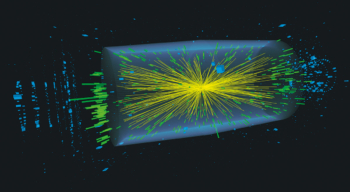A report from the ATLAS experiment.

As the harvest of data from the LHC experiments continues to increase, so does the required number of simulated collisions. This is a resource-intensive task as hundreds of particles must be tracked through complex detector geometries for each simulated physics collision – and Monte Carlo statistics must typically exceed experimental statistics by a factor of 10 or more, to minimise uncertainties when measured distributions are compared with theoretical predictions. To support data taking in Run 3 (2022–2025), the ATLAS collaboration therefore developed, evaluated and deployed a wide array of detailed optimisations to its detector-simulation software.
The production of simulated data begins with the generation of particles produced within the LHC’s proton–proton or heavy-ion collisions, followed by the simulation of their propagation through the detector and the modelling of the electronics signals from the active detection layers. Considerable computing resources are incurred when hadrons, photons and electrons enter the electromagnetic calorimeters and produce showers with many secondary particles whose trajectories and interactions with the detector material must be computed. The complex accordion geometry of the ATLAS electromagnetic calorimeter makes the Geant4 simulation of the shower development in the calorimeter system particularly compute-intensive, accounting for about 80% of the total simulation time for a typical collision event.
Since computing costs money and consumes electrical power, it is highly desirable to speed up the simulation of collision events without compromising accuracy. For example, considerable CPU resources were previously spent in the transportation of photons and neutrons; this has been mitigated by randomly removing 90% of the photons (neutrons) with energy below 0.5 (2) MeV and scaling up the energy deposited from the remaining 10% of low-energy particles. The simulation of photons in the finely segmented electromagnetic calorimeter took considerable time because the probabilities for each possible interaction process were calculated every time photons crossed a material boundary. That calculation time has been greatly reduced by using a uniform geometry with no photon transport boundaries and by determining the position of simulated interactions using the ratio of the cross sections in the various material layers. The combined effect of the optimisations brings an average speed gain of almost a factor of two.
ATLAS has also successfully used fast-simulation algorithms to leverage the available computational resources. Fast simulation aims at avoiding the compute-expensive Geant4 simulation of calorimeter showers by using parameterised models that are significantly faster and retain most of the physics performance of the more detailed simulation. However, one of the major limitations of the fast simulation employed by ATLAS during Run 2 was the insufficiently accurate modelling of physics observables such as the detailed description of the substructure of jets reconstructed with large-radius clustering algorithms.
AtlFast3 offers fast, high-precision physics simulations
For Run 3, ATLAS has developed a completely redesigned fast simulation toolkit, known as AtlFast3, which performs the simulation of the entire ATLAS detector. While the tracking systems continue to be simulated using Geant4, the energy response in the calorimeters is simulated using a hybrid approach that combines two new tools: FastCaloSim and FastCaloGAN.
FastCaloSim parametrises the longitudinal and lateral development of electromagnetic and hadronic showers, while the simulated energy response from FastCaloGAN is based on generative adversarial neural networks that are trained on pre-simulated Geant4 showers. AtlFast3 effectively combines the strengths of both approaches by selecting the most appropriate algorithm depending on the properties of the shower-initiating particles, tuned to optimise the performance of reconstructed observables, including those exploiting jet substructure. As an example, figure 1 shows that the hybrid AtlFast3 approach models the number of constituents of reconstructed jets as simulated with Geant4 very accurately.
With its significantly improved physics performance and a speedup between a factor of 3 (for Z → ee events) and 15 (for high-pT di-jet events), AtlFast3 will play a crucial role in delivering high-precision physics simulations of ATLAS for Run 3 and beyond, while meeting the collaboration’s budgetary compute constraints.
Further reading
ATLAS Collab. 2022 Comput. Softw. Big Sci. 6 7.





